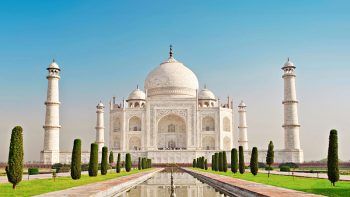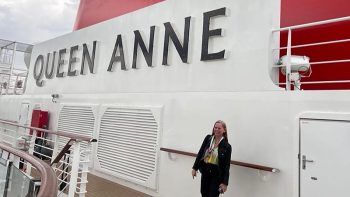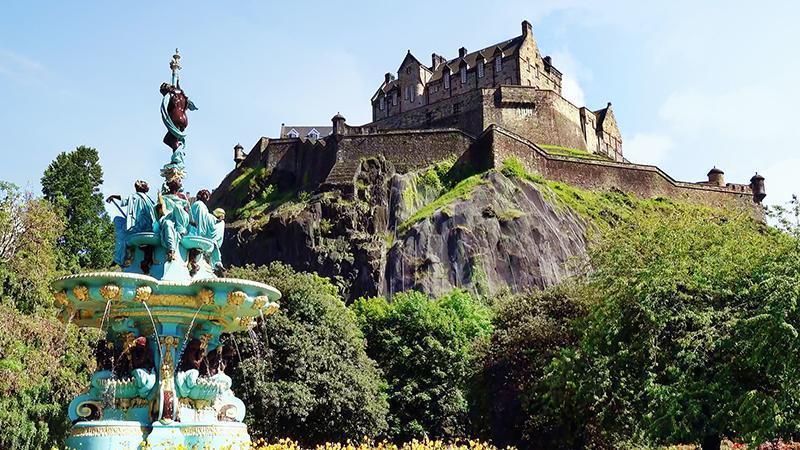
Edinburgh is one of the world’s great cities; a handsome, sturdy, regal place of stone and rock and history that seeps into your bones. There are also lovely gardens, sumptuous hotels, excellent food, and, yes, the odd place to try a wee sip of whisky.
I recently visited for a few days and did four tours and a flashy pseudo-tour that’s billed as a whisky experience. Here’s a look at all five.
MERCAT ROYAL MILE AND EDINBURGH CASTLE TOUR
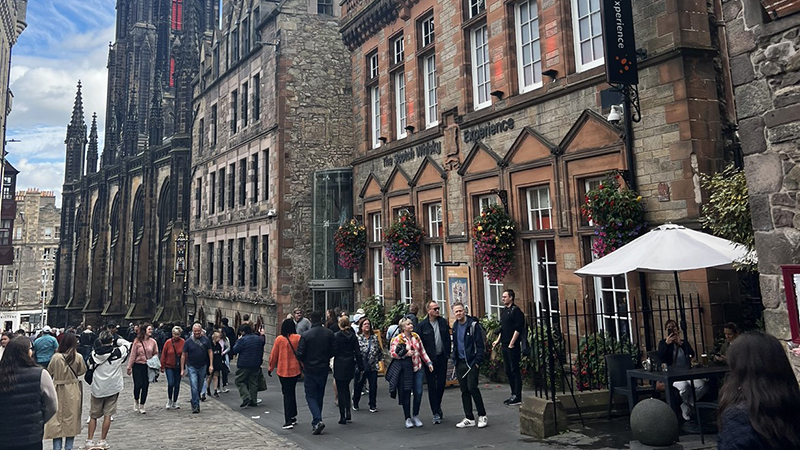
The Mercat Secrets of the Royal Mile Tour (Mercat is Scottish for market) is a very entertaining, history-filled tour that covers lots of ground. We had a wonderful guide named Veni, who said she was named after Venice, grew up in Germany, but fell in love with Scotland and moved here a couple decades ago.
Veni told us the land between the castle and the Palace of Holyrood House is called the Royal Mile, but that it’s actually a mile and 106 yards. Close enough for government work, I say.
At one time, the rocky promenade that the castle now sits on was a volcano, and lava flowed hot and mighty down its eastern side, creating what is now the Royal Mile. The original settlement here for the Scots was built here two to three thousand years ago and called Dunedin, or fortress on the hill.
Early on, Veni asked our group what we thought the number one form of entertainment was in the city hundreds of years ago. “Executions and torture,” she said. We were told there’s a nearby bar called “The Last Drop,” which refers not only to the last bit of liquid in a bottle of whisky, but the last time a criminal would feel the weight of gravity.
Outside St. Giles Cathedral (founded 899 years ago) she pointed out a statue of King Charles II on a horse that dates back to 1685. The horse was apparently hollow, and cracks allowed it to fill with water over the years. Authorities supposedly drilled a hole in the horse’s backside to relieve the pressure, which created what locals called the statue of the Piddling Pony.
“Ladies would avert their eyes when they walked past,” Veni said with another sly grin.
John Knox, the founder of the Scottish Presbyterian Church, wanted to be buried near the Cathedral and was. Later, town officials decided to move the burial ground and create a parking lot on the very ground. They did just that, but left Knox where he was and put a small plaque in the ground to show where he’s buried. Knox is one of the most famous people in this country’s history, but there he is, buried under car park spot number 23, albeit with a spiffy plaque. Veni told us the cathedral priest drives a red car and has the coveted parking spot, which seems fair.
We also prattled down Tweeddale Court to see old city walls that dates back to the mid 1400’s. After returning home I read that the court was featured in an episode of the TV show “Outlander.”
The Royal Mile being a rather popular spot for tourists, we also passed numerous gift shops selling tartans and other Scottish gear. I smiled at a hosiery store called “Soctopus” and moaned at a gift shop sign that reads “Thistle Do Nicely.”
Before heading up the former lava flow to Edinburgh Castle, Veni pointed out the Balmoral Hotel, where author JK Rowling retreated to write some of her books when fans around here became as thick as customers at 5 p.m. on a Friday at The Last Drop.
Our last stop was a quick visit to see some of the crown jewels on display. The most notable are The Honours of Scotland, the oldest crown jewels in Britain. They include a red crown ringed with silver, gold, and precious stones that was first worn by King James V in 1540.
If you opt for the package that includes Edinburgh Castle, you can skip the line-up for tickets. The same company also runs ghost tours, Halloween tours, witch tours, whisky tours and more.
COST: The Mercat Royal Mile tour without Edinburgh Castle costs 22 GBP for adults and 17 GBP for kids (roughly CAD$37 for adults and $28 for kids).
ROYAL YACHT BRITANNIA

The world’s fascination with the British Royal Family never seems to diminish, and Edinburgh is a great place to explore their history and habits.
The Royal Yacht Britannia was one of the late Queen Elizabeth II’s favourite possessions, and you can take a tour of her (the boat, not the queen) on the Edinburgh waterfront. It’s a massive ship that weighs almost 6,000 tons and stretches 412 feet and 3 inches, making it a little more than one-third the size of Cunard’s Queen Mary II.
You can book a private tour, but we opted for the audio tour (xxxx GBP, about xxx CAD or xxx USD), which requires a good 90 minutes to complete.
I was amused straightaway by the audio description, which insisted with a seemingly straight voice that the emphasis for the Royal Yacht Britannia was simplicity. Ahem. It’s true that all the beds (except the double mattress used by Prince Charles and Diana for their honeymoon) are singles. And it’s also true that the Queen’s quarters are relatively modest; more Cleveland Holiday Inn than Paris Four Seasons. But the Royal Family insisted on having a Rolls Royce on board at one point, and it’s said it took three hours to set the dining room table with ornate silver for visiting dignitaries such as Bill Clinton and Nelson Mandela.

Still, it’s interesting to hear how the ship was launched in 1953 and ultimately decommissioned (much to the Queen’s dismay) in 1997. It’s also instructive to see the staff quarters down below, which featured lots of bunk beds and, in a nod to the 1990s, a visible stack of cassette tapes.
It’s a fun tour for people of all ages, and they’re strategically placed stuffed toy Corgi dogs in various parts of the ship for a game kids can play. There is, naturally, an immense gift shop with Corgis and royal doodads of all kinds. They also do special events, including dinners in the dining room and Hogmanay (New Year’s Eve) programs.
As you walk towards the ship, look for the photo of Diana greeting Harry and William on a visit to Toronto. It’s one of the best photos I’ve seen of her; bursting with exuberance and true love. In retrospect, it’s almost heartbreaking.
COST: $18.50 GBP (About $31 CAD). Discounts for students and families.
PALACE AT HOLYROOD HOUSE

At the end of the Royal Mile you’ll find the Palace at Holyroodhouse, where the royal family stays when they have business to conduct in Edinburgh. The audio tour doesn’t try to play down the pizzazz, including a royal bed rimmed by deep red curtains, 16th-century tapestries and a large dining room that no doubt hosted some lively conversations over the years. Above the grand staircase, check out the life-size angel holding the Scottish crown.
Just outside the former bed chamber of Mary Queen of Scots is one of the most famous places in the palace. It’s where Mary’s private secretary, David Rizzio, was killed by her jealous husband and a gang of Scottish lords. Poor Rizzio was stabbed 56 times, and his body was left on display for all to see. I didn’t see it, but some say you can still spot blood stains on the floor.
As you progress through the palace, each room seems to be more and more posh. Our audio narrator explained that it was designed that way, seemingly so the guest would be so overcome or discombobulated by the time they see his or her majesty that they’d simply stare or perhaps give in to the royal request of the day with a mindless nod.
The ruins of the medieval abbey out back (it was built in 1128) are very cool and mysterious, and there are lovely gardens brimming with brilliant flowers.
COST $18 GBP for an advance adult ticket (about CAD$30)
REAL MARY KING’S CLOSE

This is a tour where someone in costume leads you into a narrow close, which is what the Scots call the tiny laneways that lead down the hill from the Royal Mile. The Real Mary King’s Close is in the heart of the mile, just across from St. Giles Cathedral. It’s a fun way to learn about the city’s colourful history and how people lived.
Our guide told us that people with money burned beeswax for light in the dark rooms of the close but that the poor had to burn cow fat or fish oil, which made the city aromatic enough to smell from a mile away.
We also saw a replica of the type of room where Mary Queen of Scots might have stayed back in the day. Apparently, she only spent one day in the city in her life, and that was the night before she abdicated. Her loss, I say.
One of the more gruesome parts of the tour focuses on the plague, where I learned there was both a bubonic plague (roughly 50% survival rate) and a pneumonic plague, which killed something like 95% of its victims. Bubonic plague victims developed immense boils that were sometimes the size of a fist, which would be opened and then lanced with a burning stick.
There was also some ghost talk, of course, and (to my mind) a little too much talk about emptying bed pans in tight quarters. This task was usually accompanied by a warning shout of “gardy loo,” which is a rough French translation of “gardez l’eau,” or “watch out for the water.”
A history scholar might scoff at this tour, but it’s a fun attraction that a family would probably enjoy.
Cost: 21 GBP and up for adults (roughly CAD$35), 15 GBP for those 15 and under.
THE JOHNNIE WALKER WHISKY EXPERIENCE
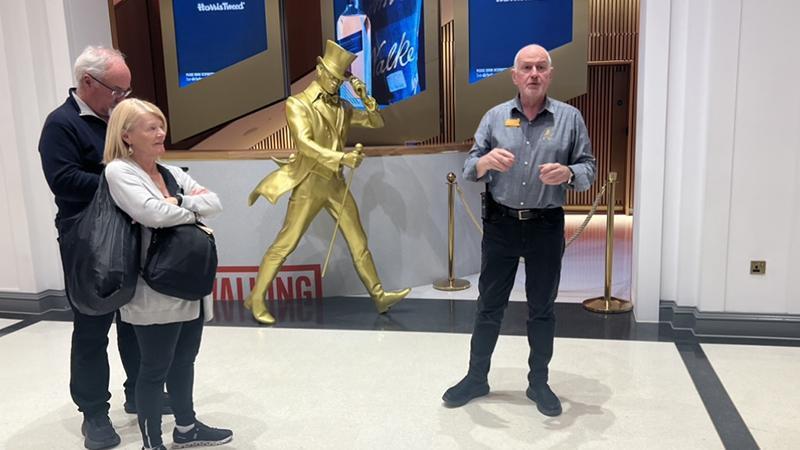
The Johnnie Walker Princes Street Edinburgh Whisky Experience isn’t really a tour so much as a high-tech, whisky extravaganza. That being said, it’s fairly educational, quite engaging, and very tasty.
Before you start, you’re asked to tell them a little bit about yourself to build a flavour profile for the type of whisky (most folks here don’t call it Scotch; it’s just whisky) you might like. For example, you might be asked, “How often do you eat a banana,” or “How do you feel about rosemary?” Once they’ve established your flavour faves, you’re given a wristband in a certain colour that you will use later to create a whisky cocktail you might like.
Our guide/host, Patrick, was an entertaining fellow with a very good sense of humour, and not overly cheesy. Most Scots would run screaming into the night if you mixed whisky and Coke, but Patrick insisted there are no rules.
After his intro, we went into a small theatre with a woman reclining in a chair, drinking a (mock we assume) glass of whisky. She quickly rose up and did an active talk about the distillery’s history in front of a screen flashing bright images while she moved about and mimicked the “Johnnie Walker walking man” logo.
We learned that Dear John got started in business when he opened a grocery store in the Scottish town of Kilmarnock in 1820. He brought in tea from around the world (light bulb moment approaching) and started blending the best ones into special mixes. One magical day, he awoke and decided to try the same thing with whisky, which was pretty rough around the edges at the time.
Voila! Blended whisky was born. Some single malt aficionados may frown, but with Johnnie Walker, you get dozens and dozens (29 of them into Johnnie Walker Black Label) of single malt products blended into a bottle that tastes identical year after year after year.
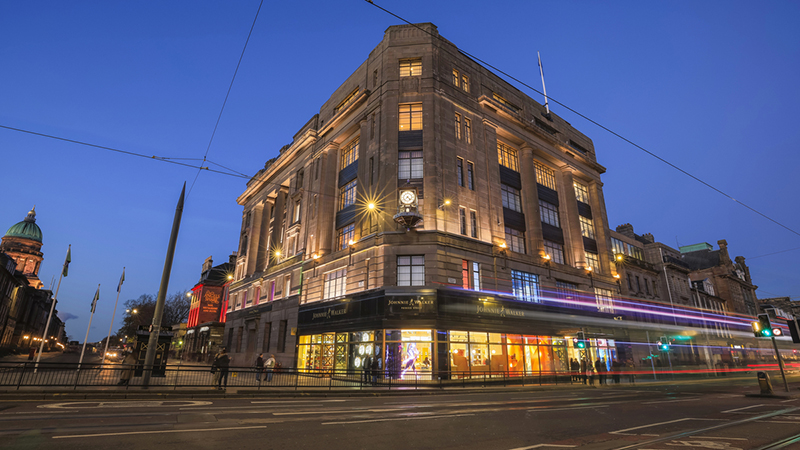
Distilled grain and water are big deals in Scotland, probably even more important to the Scottish psyche than wine is to the French. Somewhere in her discussion, our performing walker/entertainer/lecturer issued a wise comment: “You can’t separate whisky from Scottish culture, and you can’t separate Scottish culture from whisky.”
Following her performance, it was time to enter a bright tasting room, where a machine served up a whisky and soda cocktail that matched our flavour profile. Guests then choose from a variety of bits to float on top for added flavour, including everything from dried pineapple to sun-dried tomatoes.
After passing a sign that said “Today’s rain is tomorrow’s whisky,” we learned more about how whisky is made. There’s only water, yeast and barley, we were told. Some whisky is air dried, but some is dried over peat for that smoky flavour that many whisky drinkers adore.
Our final stop was a tasting room, where we could order drams of whisky to try on our own or have the bartenders create something special. I chose a spicy old-fashioned with Johnnie Walker Black Label whisky, a bit of tawny port, a few drops of Angostura bitters, and some crystallized ginger. My notes are a little hazy, but I seem to recall proposing to the bartender.
Tickets cost 30 GBP (roughly CAD$50). You also get 10% off in the gift shop, so that’s a bonus.


